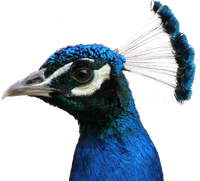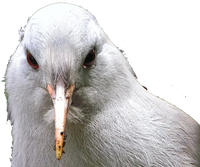|
| Osprey[1] Temporal range: 26–0 Ma Miocene to Present | |
|---|---|

| |
| P. h. carolinensis (nicknamed "American Osprey") subspecies. | |
| Scientific classification | |
| Kingdom: | Animalia |
| Phylum: | Chordata |
| Class: | Aves |
| Clade: | Inopinaves |
| Clade: | Afroaves |
| Superorder: | Accipitrimorphae Fain & Houde, 2004 |
| Order: | Accipitriformes Vieillot, 1816[1] |
| Family: | Pandionidae Bonaparte, 1854[1] |
| Genus: | Pandion Savigny, 1809[3] |
| Species: | P. haliaetus |
| Binomial name | |
| Pandion haliaetus Linnaeus, 1758[3] | |
| Subspecies | |
|
P. h. haliaetus | |
| File:Wiki-Pandion haliaetus.png | |
| Synonyms | |
|
Falco Haliaetus (Linnaeus, 1758) | |
Osprey, Pandion haliaetus (pan-DIE-on hal-ih-ay-EE-tus[4]) is a species of raptor, it is the only species found in the family Pandionidae and the genus Pandion. Together, with Cathartidae, Sagittariidae and Accipitridae, they make up Accipitrimorphae.[1] They are widespread in the Northern Hemisphere and Australia.[5]
"Osprey" comes from the Latin "ossifragus", meaning "bone breaker", but this name probably refers to another species[5], the Lammergeier.[6] Pandion was the name of the two mythical kings of Athens; haliaetus is from the Greek hals meaning "sea" and aetos meaning "eagle".[5]
In 1994, the osprey was declared the provincial bird of Nova Scotia, Canada.[7]
| Click for other names | |
|---|---|
| Other common names | Formerly known as Fish Hawk.[8] |
| French | Balbuzard pêcheur |
| German | Fischadler |
| Spanish | Águila pescadora |
| Scientific | Falco Haliaeetus |
| Contents: |
|---|
|
Taxonomy • Description • Similar species • Behaviour • Diet • Calls • Reproduction • Distribution/habitat • References • External links |
Taxonomy
It is sometimes placed in Accipitridae[Note 1], although current consensus places them in their own family, Pandionidae[Note 2] It was also part of Sibley and Ahlquist's expanded Ciconiiformes.[9]
It is sometimes split into two species: Western Osprey and Eastern Osprey.
The Osprey has four subspecies:
- Western Osprey, P. h. haliaetus (Linnaeus, 1758)
- "American Osprey", P. h. carolinensis (J. F. Gmelin, 1788)
- "Caribbean (or Ridgway's) Osprey", P. h. ridgwayi Maynard, 1887
- Eastern Osprey, P. h. cristatus (Vieillot, 1816)
Description
Ospreys are mid-sized, long-winged, two-toned raptors.[10] They lack a supraorbital ridge, which makes them look pigeon-headed.[5] Length is 50–66 cm (20–26 in); wingspan is 127–174 cm (4.17–5.71 ft); males weigh 1.2–1.74 kg (42–61 oz) while females weigh 1.21–2.05 kg (43–72 oz).[10] The wing chord measures 38 to 52 cm (15 to 20 in), the tail measures 16.5 to 24 cm (6.5 to 9.4 in) and the tarsus is 5.2–6.6 cm (2.0–2.6 in).[11] Sexes alike,[12] though the female may show darker, streaking on neck,[13][14] and clear-breasted, unmarked adult birds are usually but not always, males.[5]

Feet showing the spicules.
They differ from other diurnal birds of prey — hawks, eagles, kites, falcons, for example — in certain parts of its internal structure,[4] and outwardly in its long, strong claws, curved about one-third of a circle, and completely round (not concave and grooved underneath), in equal length of its toes (not unequal like in other raptors), and in the heavy, peculiarly scaled (reticulated) tarsus (shank), and the short, dense feathering of the thighs.[15][4] Their outer toes, like owls, are reversible;[4][13][5] this character and the sharp spicules on the pads of the toes allow them to grasp slippery fish;[4][5] they also have a closeable nostril.[9] They have a peculiar oily odour that permeates on its feathers and on its eggshells, for many years.[16][4] Its plumage is compact, which helps blunt its impact and reduces wetting when it plunges into the water.[17][4] Blackish-dark brown above, white below; head is largely with a broad black cheek patch.[10][18][13] Shows a band of darker streaks on breast, heaviest and more prominent in the female.[10][14] Black bill with pale grey base; eyes are yellow in adults; upper legs are feathered white and the lower tarsi are grey.[10]
Juvenile as adult, but feathers on mantle and upperwing fringed pale.[19] Eyes are orange.[10] Flight feathers with pale white tips.[14]
Birds with few white feathers in place of normally dark ones have been reported; melanistic individuals have been reported in Florida and France[real world] [Devonshire].[alt. univ.][5]
In flight, shows long narrow wings are bent back at the "wrist", dark carpal patches are conspicuous, wings slightly arched when soaring[13]; wrists usually held up and forward, outer wings bent down and back, creating an "M"-shape silhouette from below or head-on.[14]
Bones belonging to earlier Pandion species from the mid- to late-Miocene (approx. 13 million years ago) were found in California and Florida. These prehistoric osprey species were slightly less robust than modern ospreys, but otherwise very similar.[20]
Similar species
Bald Eagles are larger, usually have dark bodies, fly with level wings, and lack black carpal patches on their underwings. Large gulls can appear very Osprey-like but are smaller and have shorter, pointed wings, longer necks, and unbanded tails, and lack the black carpal patches on the underwings.[5]
Behaviour
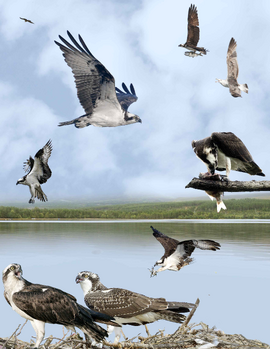
Composite image of P. h. haliaetus.
Wingbeats are deep while flying; hovers while hunting fish.[14] Typically seen flying, or perched alone on a high exposed branch near water.[21] Active flight is with slow, steady, shallow wingbeats on somewhat flexible wings. It soars and glides with its wings in a crooked in a gull-like shape,[5] with its wrists cocked forward and held above body level and wingtips pointed down and back.[5] Soars sometimes on flat wings; hovers frequently while hunting over water.[5] Their flight speed, recorded in migration in Pennsylvania at 20–80 miles per hour ([convert: unknown unit])[22] and when in the western US, 25–27 miles per hour ([convert: unknown unit])[23][4]
Spends much of its time near water, perched on dead snag of trees or on rocks; flies out occasionally over fresh or salt water to hunt; flies about 30–100 ft (9.1–30.5 m) above surface.[4]
When it sights a fish, hovers with wings beating, legs trailing under body, may sometimes plunge into water from straight flight; in dive, feet and head project forward ahead with wings held above back, tail spread; may strike water with tremendous splash; sometimes disappears below the surface of the water, with only wingtips showing.[4]
Rises from the water with fish gripped in both feet, it pauses in midair to shake water from plumage (see video of it hunting), and to arrange fish with the head pointing forward, which reduces its resistance to the air. Flies with its fish to its habitual perch to eat or to nest to feed its young.[4]
Other raptors and even herons sometimes rob Ospreys of fish,[11] but cases of intraspecific piracy apparently very rare and perhaps the result of extreme hunger.[24]
Ospreys, while flying, may sometimes swoop down and drag their feet through the water, a practice that's thought to cool or clean their feet but may also be a displacement behaviour.[5]
Ospreys may occasionally lock onto a salmon or sturgeon that's too large and may drown or break its wings when hitting the water too hard.[4]
Diet

Osprey -- the ultimate fisher
An Osprey plunging and hunting fish.
Forages mainly in flight, but sometimes still-hunts from perch.[11] Foraging behaviour varies with wind conditions. Seldom hovers at wind speeds below 3 m/s (6.7 mph); most hovering flights last 2–5 s (range 1–41 s).[25] Dramatic dives![]()
![]() from heights usually of 10–30 m (33–98 ft) (overall range 5–75 m (16–246 ft)), but seldom goes much below surface of water.[11] Secures fish in talons before flying off.
Normally feeds alone but can gather in small flocks where fish plentiful, especially if species involved, e.g. winter flounder (Pseudopleuronectes americanus), is available only periodically and is patchily distributed.[26]
from heights usually of 10–30 m (33–98 ft) (overall range 5–75 m (16–246 ft)), but seldom goes much below surface of water.[11] Secures fish in talons before flying off.
Normally feeds alone but can gather in small flocks where fish plentiful, especially if species involved, e.g. winter flounder (Pseudopleuronectes americanus), is available only periodically and is patchily distributed.[26]
Feeds exclusively on fish, up to the size of 150–300 g (0.33–0.66 lb), with fish up to 2,000 g (4.4 lb) reported.[11] Its prey include alewives, herring, bluefish, blowfish, bonito, bowfin, carp, catfish, eels, flounders, flying fishes, goldfish, horned pout, menhaden, mullet, perch, pickerel, pike, salmon, shad, squeteague, suckers, and many others; also occasionally catches and eats small rodents and small birds.[4][27] Bent (1937), cites an amusing experience W.B. Savary, who watched an osprey catch and lose in a succession four blowfish, or swellfish, Spheroides maculatus, one of the spiny-rayed saltwater fishes of the Atlantic; the fish escaped by inflating themselves until the Osprey's talons lost their hold and the fish dropped back into the water.[4][28]
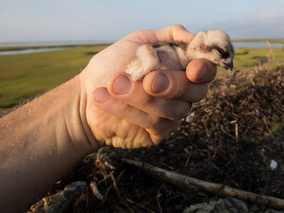
A researcher holding a hatchling Osprey.
Ospreys are also known to catch snakes, frogs, storm-petrels, sandpipers, ducks, possibly at times when fish are not available.[4][28] May also feed on mammals[27], such as voles, squirrels and muskrats.[20] Tait, et. al. (1972) watched an osprey carrying an unidentified mammal.[29] Has also been seen feeding on salamander and a small alligator.[20] Known to drop conch shells on to hard surface to extract mollusc inside.[30] Reports of ospreys feeding on carrion are rare. However, they have been observed eating dead White-tailed Deer and Virginia Opossum.[20]
Remains of birds found in nests in Arabia were up to the size of Socotra Cormorant and Slender-billed Gull, however; it is unknown as to how or if they were caught by an Osprey.[30]
Ospreys probably get most of the water they need from the flesh of their prey, although there are reports of adults drinking on hot days.[31]
Ospreys catch fish on 24 to 74% of their dives. This success rate is affected by individual ability, weather and tide. Some studies have shown that ospreys are most successful hunting at midtide and when the weather is calm.[20]
Calls

Osprey Calling - Loud and Long!
A male Osprey calling.
Ospreys have eight different vocalizations (alarm, solicitation low, high and very high, guard, excited, screaming, and copulation calls) identified and some sexual differences in the frequency with which different calls are used.[32] The calls of an Osprey consists of melodic ascending whistles including the "chewk-chewk-chewk" or the familiar "kip-kip-kip".[33] In display it gives off a series of yeelp-yeelp-yeelp.... When alarmed, it utters a hoarse, sharp kew-kew-kew-kew.[19] However, it is relatively silent away from its nest-site, and noisy near it.[34]
Reproduction
Courtship flights by males are a series of undulating dives and climbs, usually performed while the bird is carrying a fish and calling constantly.[5]
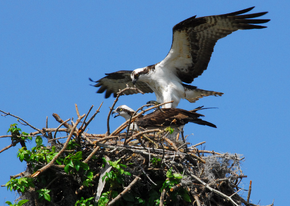
A pair on the nest, about to mate.
Season varies with region: generally in spring and summer in temperate latitudes, winter to spring in tropical and subtropical latitudes, and Red Sea region, Jul–Nov in N Australia and Aug–Feb in S Australia).[11]
Most pairs are monogamous, but polygynous trios form where males can easily defend two nest-sites and there are also records of polyandrous trios in S Australia.[35] However, polygyny can also occur in rare instances where nest sites are close enough together that a male can defend two nests. When this occurs, the first nest usually experiences higher reproductive success than the second because the male devotes more resources to that nest.[36]
Helpers at nest in Arabia correlates with a high breeding success.[30] Loose colonies of up to 300 pairs[26] in some areas usually result of spatial distribution of safe nest-sites, but also reduces predation risks.[37]
Male largely feeds female throughout pair formation to egg-laying period, and rate of such courtship feeding is apparently strongly correlated with male's ability to deliver food during chick-rearing phase.[38]
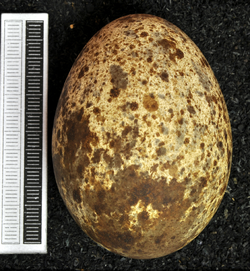
Egg, Collection Museum Wiesbaden.
The nest, which can weigh up to a 2,000 lb (910 kg)[4], is a large collection of sticks and flotsam (even including bones),[11] lined with grass and moss, if available.[11] It is usually wedged up high, up to 30 m (98 ft) in an exposed tree or mangrove.[11] Will nest on a cliff, preferred in Corsica[32] and in Japan (which can be up to 90 m (300 ft) above ground)[39]; also uses power poles, disused buildings![]() [11], a buoy, a specialized platform, channel markers, duck blinds, navigation aids, telephone poles, small wooden docks,[5] or on the ground in predator-free islands (e.g. in the Red Sea)[11]; always with clear, all-round visibility.[39] Nest is frequently reused in subsequent seasons; exceptionally favoured sites may be reused,[11] although perhaps not annually, for almost 100 years.[30] Adults will vigorously defend their nests, but rarely attack humans.[5]
[11], a buoy, a specialized platform, channel markers, duck blinds, navigation aids, telephone poles, small wooden docks,[5] or on the ground in predator-free islands (e.g. in the Red Sea)[11]; always with clear, all-round visibility.[39] Nest is frequently reused in subsequent seasons; exceptionally favoured sites may be reused,[11] although perhaps not annually, for almost 100 years.[30] Adults will vigorously defend their nests, but rarely attack humans.[5]
A range of other species has been recorded as nesting within or directly below active nests of present species, or on same structure as latter, among them, in the Great Lakes region: Common Grackle (Quiscalus quiscula), Tree Swallow (Tachycineta bicolor), Common Starling (Sturnus vulgaris), House Sparrow (Passer domesticus), Northern Flicker] (Colaptes auratus) and Barn Swallow (Hirundo rustica).[40] In Arabia and Red Sea region, where ground nests predominate, old nests may be reused by ground-nesting seabirds, as well as Egyptian Goose (Alopochen aegyptiaca) and other birds, while herons and terns may breed in close proximity to active nests.[30] Other larger species will usurp osprey nests for their own use in the spring before the resident Ospreys return. In North America, these species include Great Blue Herons, Canada Geese, Bald Eagles, Red-tailed Hawks, Great Horned Owls, Herring Gulls and Common Ravens.[20]

An Osprey standing next to a massive nest.
Clutch 1-4 eggs, normally 3, creamy to yellowish, variably spotted chestnut-red, dark brown and pale greyish,[41] with quite marked variation in egg size and volume at least within Australia.[42] in W Palearctic 61.6 mm × 46.4 mm.[41]
Incubation is 34[11]-43 days, commencing with first egg and by both sexes;[41] female does not catch fish herself during her incubation, but depends on the male to help feed her.[4] Chicks tend to hatch sequentially, 1–7 dys apart, and youngest chicks disadvantaged when food scarce. Fratricide can also occur even in areas of high food abundance.[43] Young make their first flights 51-59 (usually 52-53) after hatching; after 48-59 days, young will fly back to the nest, although awkwardly.[44][4] Banding shows that some young Ospreys return to natal area when two years old, or in their third year, as they do not breed until three years old,[45][46][4] but assumes adult plumage when c. 18 months old.[11]
Fledging success in Nova Scotia discovered to be greater on coast than inland, pairs on coast loosely colonial;[26] in Saudi Arabia 1·5 young fledge per successful attempt, but throughout Red Sea 82% of hatchlings fledge and there are frequent records of four young fledging from one brood.[30] Some studies have revealed that local declines in fish stocks can lead to decreased brood size and increased inter-sibling aggression.[47] Growth rates similar for males and females, and sexual size dimorphism has been speculated to be independent of sibling competition in this species.[48]
Lightning sometimes strikes the nest, with the young or female killed or injured;[49][4] other dangers include predators such as Bald Eagles and Great Horned Owls feeding on nestlings; while raccoons, snakes and other climbing animals are suspected predators of eggs and nestlings, which may explain why the majority of their nests, such as in the Chesapeake Area, are built over water.[50][20] However, a replacement clutch may be laid within 2–3 weeks if first eggs lost and suitable alternative site available.[30]
Distribution/habitat
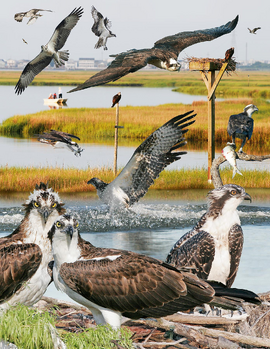
A composite image of P. h. carolinensis.
Ospreys are typically found in areas consisting of shallow waters, fresh, brackish and marine. Nests along lakeshores, seashores, marshes and rivers; also on deadwood swamps and reservoirs. Highest densities generally near salt water, especially saltmarshes, mangrove swamps, coastal lagoons and bays. Favours islands for nesting, thereby gaining protection from predators. Becomes accustomed to human activity, so tolerates suburban, even urban habitats. Feeds in rivers, bays, marshes, reservoirs, lakes and ponds, wherever fish are available near water surface. In Japan distribution seems limited to some extent by presence of White-tailed Eagle (Haliaeetus albicilla);[39] a similar, but sometimes short-lived negative correlation with the presence of Bald Eagle (Haliaeetus leucocephalus) exists in North America.[34]
Resident in tropical and subtropical latitudes, although even here individuals can move up to 350 km from their natal area.[30] Migratory elsewhere, generally moving to latitudes near the equator: Amazon Basin and N coast of South America (arriving between 11th Aug and 5th Nov);[51] and coastal W Africa from Senegal to equator;[52] intratropical migrations also reported in E & NE Africa;[53] in S Africa, e.g. Malawi, species is present mainly Aug–Apr, but farther N, e.g. in Uganda (where unsubstantiated claims of breeding), seemingly present more or less throughout year.[54]
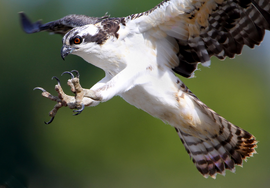
A juvenile. Note the orange eyes, scalloping on its wings, as well as the slit-like nostrils and spicules on its feet.
Migration, at least in Americas, appears concentrated along well-defined, narrow fronts and uses land-bridges wherever possible, as opposed to broad-front movements and long water crossings; nonetheless, those breeding in E & C USA migrate to South America primarily through Antilles (moving from Florida to N Cuba and then E to Haiti and S over Caribbean),[51] rather than via the Mesoamerican land-bridge.[55] In North America, females depart earlier on migration and travel farther than males, while W USA birds spend longer on passage than those in midwest.[51] Mean daily distances travelled vary from 111 kilometres (111,000 m)/day to 380 kilometres (380,000 m)/day.[51]
Majority of Ospreys that breed in Eurasian move to sub-Saharan Africa, S coast of Arabia, Indian Subcontinent, and region from SE Asia E to Philippines and Sulawesi.[11] Generally migrates singly, and movement therefore not particularly striking; in migration studies on Malta during four autumns 2009–2012, count totals of this species ranged from just 22 to 49 individuals.[56] On passage crosses reasonably high mountains, e.g. the Pyrenees (France–Spain border).[57]
That vagrants have been reported in Greenland, Iceland, Faeroes, Azores and Madeira, as well as in Seychelles, attests to the species' ability to make long over-water movements.[11]
Ospreys in some areas, particularly boreal and other northern forested regions, may have historically been dependent on beavers for creation of habitat. Beavers create osprey habitat by building dams, which create shallow ponds for fishing and dead trees appropriate for building nests.[20]
References
Notes
Cited text
- ^ a b c d John H. Boyd III (January 26, 2012). "ACCIPITRIMORPHAE: Cathartiformes, Accipitriformes". TiF Checklist. Retrieved 19-04-2024. Check date values in:
|access-date=(help) - ^ BirdLife International (2008). "Pandion haliaetus". 2008 IUCN Red List of Threatened Species. Retrieved 24 February 2009.
- ^ a b "Pandion haliaetus ". Integrated Taxonomic Information System. Retrieved 29 April 2014.
- ^ a b c d e f g h i j k l m n o p q r s t Terres, John K. (1980). The Audubon Society Encyclopedia of North American Birds. Alfred A. Knopf, Inc. ISBN 0394466519.
- ^ a b c d e f g h i j k l m n o p Clark, William S.; Brian K. Wheeler (2011). Hawks of North America, 2nd Edition. Boston, MA: Houghton Mifflin Company. p. 12. ISBN 0395670675. Cite uses deprecated parameter
|coauthors=(help); - ^ J. Simpson, E. Weiner (eds), ed (1989). "Osprey". Oxford English Dictionary (2nd ed.). Oxford: Clarendon Press. ISBN 0-19-861186-2.
- ^ "The Osprey". gov.ns.ca. Province of Nova Scotia. External link in
|website=(help) - ^ Austin, Oliver L.; Singer, Arthur (1961). Birds of the World. LCCN 61-13290.
- ^ a b Simpson & Day (1999). A Field Guide to the Birds of Australia, 6th Edition. Penguin. ISBN 0-691-04995-5.
- ^ a b c d e f Brazil, Mark (2009). Birds of East Asia: China, Taiwan, Korea, Japan, and Russia. Princeton University Press. ISBN 97801691139265 Check
|isbn=value: length (help). - ^ a b c d e f g h i j k l m n o p Ferguson-Lees, J. & Christie, D.A. (2001) Raptors of the World. Christopher Helm, London.
- ^ Peterson, Roger Tory (1980). A Field Guide to the Birds East of the Rockies. Houghton Mifflin Company. ISBN 039526619X.
- ^ a b c d Dunn, Jon L. and Alderfer, Jonathan (2011). National Geographic Guide to the Birds of North America. National Geographic Society. ISBN 1426200722.
- ^ a b c d e Stokes, Donald W. and Stokes, Lilian Q. (2010). Stokes Field Guide to the Birds of North America. Little, Brown and Company. ISBN 9770316010504 Check
|isbn=value: invalid prefix (help). - ^ Friedman, H. (1950) The birds of North and Middle America. US Natl. Mus. Bull. no. 50. Washington, DC.
- ^ Wetmore, A. (1937a) Eagles, hawks vultures. In The book of birds. ed. G. Grosvenor and A. Wetmore. Vol 1. Washington, DC. Natl. Geographic Soc.
- ^ Brown, L. and Amadon, D. (1968) Eagles, hawks, and falcons of the world, two vols. New York: McGraw-Hill Book Company.
- ^ Peterson, Roger Tory (1961). A Field Guide to Western Birds. Houghton Mifflin Company. ISBN 039513692X.
- ^ a b Arlott, Norman (2009). A Field Guide to the Birds of the Palearctic Non-Passerines. Harper Collins Publishers Ltd. ISBN 9780007155651.
- ^ a b c d e f g h Ref: Poole, A., R. Bierregaard, M. Martell. 2002. Osprey (Pandion haliaetus). A Poole, F Gill, eds. The Birds of North America, Vol. 683. Philadelphia, PA: The Birds of North America, Inc..
- ^ Hilty, Steven L.; Brown, William L.; Tudor, Guy; Gwynne, John; Trimm, H. Wayne; Kleinbaum, Michel; et al. (1986). A Guide to the Birds of Colombia. Princeton University Pree. ISBN 069108372X.
- ^ Broun, M. and Goodwin, B.V. (1943) Flight speeds of hawks and crows in flight. Auk 60:486-92
- ^ Cottam, C; Williams, C.S. and Sooter, C.A. (1942a) Flight and running speeds of birds. Wilson Bull. 54:121-31.
- ^ Forbes, L.S. (1991) Intraspecific piracy in Ospreys. Wilson Bulletin 103(1): 111-112.
- ^ Strandberg, R., Alerstam, T. & Hake, M. (2006) Wind-dependent foraging flight in the Osprey Pandion haliaetus. Ornis Svecica 16(3): 150-163.
- ^ a b c Flemming, S.P., Smith, P.C., Seymour, N.R. & Bancroft, R.P. (1992) Ospreys use local enhancement and flock foraging to locate prey. Auk 109(3): 649-654. Cite error: Invalid
<ref>tag; name "Flemmingetal" defined multiple times with different content - ^ a b Wiley, J.W. and Lohrer, F.E. (1973). Additional records of non-fish prey taken by the ospreys. Wilson Bull. 85(4):468-70
- ^ a b Bent, Arthur Cleveland (1937) Life histories of North American birds of prey. US Natl. Mus. Bull. no. 174. Washington, DC.
- ^ Tait, W.W.; Johnson, H.M.; and Courser, W.D. (1972). Osprey carrying a small mammal. Wilson Bull. 84:341.
- ^ a b c d e f g h Jennings, M.C. (2010) Atlas of the Breedings Birds of Arabia. Fauna of Arabia 25. King Abdulaziz City for Science and Technology, Saudi Wildlife Commission & Senckenberg Forschungsinstitut und Naturmuseum, Riyadh & Frankfurt am Main.
- ^ "Osprey". All About Birds. Cornell Lab of Ornithology. – P. h. carolinensis
- ^ a b Bretagnolle, V. & Thibault, J.C. (1993) Communicative behavior in breeding Ospreys (Pandion haliaetus): description and relationship of signals to life history. Auk 110(4): 736-751.
- ^ Krista Kagume (2005). Compact Guide to Ontario Birds. Lone Pine Publishing. ISBN 1551054671.
- ^ a b (Subscription required) Poole, A.F., Kirwan, G.M., Christie, D.A. & Marks, J.S. (2014). Osprey (Pandion haliaetus). In: del Hoyo, J., Elliott, A., Sargatal, J., Christie, D.A. & de Juana, E. (eds.) (2014). Handbook of the Birds of the World Alive. Lynx Edicions, Barcelona. (retrieved from http://www.hbw.com/node/52947 on 20 April 2015).
- ^ Dennis, T.E. (2007) Reproductive activity in the Osprey (Pandion haliaetus) on Kangaroo Island, South Australia. Emu 107(4): 300-307.
- ^ Poole, A. 1994. Family Pandionidae (Osprey). Pp. 42-50 in J Del Hoyo, A Elliott, J Sargatal, eds. Handbook of the Birds of the World, Vol. 2. Barcelona: Lynx Edicions.
- ^ Hagan, J.M. & Walters, J.R. (1990) Foraging behavior, reproductive success, and colonial nesting in Ospreys. Auk 107(3): 506-521.
- ^ (Subscription required) GREEN, D. J. and KREBS, E. A. (1995), Courtship feeding in Ospreys Pandion haliaetus: a criterion for mate assessment?. Ibis, 137: 35–43. doi: 10.1111/j.1474-919X.1995.tb032
- ^ a b c Shoji, A., Sugiyama, A. & Brazil, M.A. (2011) The status and breeding biology of Ospreys in Hokkaido, Japan. Condor 113(4): 762-767.
- ^ Ewins, P.J., Miller, M.J.R., Barker, M.E. & Postupalsky, S. (1994) Birds breeding in or beneath Osprey nests in the Great Lakes basin. Wilson Bulletin 106(4): 743-749.
- ^ a b c Harrison, C.J.O. & Castell, P. (2002) Bird Nests, Eggs and Nestlings of Britain and Europe with North Africa and the Middle East. Second revised edn. HarperCollins, London.
- ^ Olsen, P.D. & Marples, T.G. (1993) Geographic variation in egg size, clutch size and date of laying of Australian raptors (Falconiformes and Strigiformes). Emu 93(3): 167-179.
- ^ Steidl, R.J. & Griffin, C.R. (1991) Growth and brood reduction of mid-Atlantic coast Ospreys. Auk 108(2): 363-370.
- ^ Stotts, V.D. and Henny, C.J. (1975) The age at first flight of young American ospreys. Wilson Bull. 87(2):277-78
- ^ Henny, C.J. and Wight, H.M. (1969) An endangered osprey population: Estimates of mortality and production. Auk 86:188-98.
- ^ Postupalsky, S. (1971) Bald eagle and osprey study in Michigan and Ontario: A report of 1969 and 1970 nesting season. California Condor 6(1):1-3
- ^ McLean, P.K. & Byrd, M.A. (1991) Feeding ecology of Chesapeake Bay Ospreys and growth and behavior of their young. Wilson Bulletin 103(1): 105-111.
- ^ Schaadt, C.P & Bird, D.M. (1993) Sex-specific growth in Ospreys: the role of sexual size dimorphism. Auk 110(4): 900-910.
- ^ Abbott, C.G. (1911) The home-life of the osprey. London: H.F. Witherby & Co.
- ^ Poole, A. 1989. Ospreys: A Natural and Unnatural History. New York: Cambridge University Press.
- ^ a b c d Martell, M.S., Solensky, M., Henny, C., Nye, P. & McMillian, M. (2002) Fall migration of North American Ospreys as determined by satellite telemetry. P. 139 in: Yosef, R., Miller, M.L. & Pepler, D. (2002) Raptors in the New Millenium. Proceedings of the World Conference on Birds of Prey & Owls. International Birding & Research Center, Eilat.
- ^ Borrow, N. & Demey, R. (2001) Birds of Western Africa. Christopher Helm, London.
- ^ Ash, J.S. & Miskell, J.E. (1998) Birds of Somalia. Pica Press, Nr. Robertsbridge, UK.
- ^ Carswell, M., Pomeroy, D., Reynolds, J. & Tushabe, H. (2005) The Bird Atlas of Uganda. British Ornithologists’ Club & British Ornithologists’ Union, Oxford, UK.
- ^ Farmer, C.J., Safi, K., Barber, D.R., Newton, I., Martell, M. & Bildstein, K.L. (2010) Efficacy of migration counts for monitoring continental populations of raptors: an example using the Osprey (Pandion haliaetus). Auk 127(4): 863-870.
- ^ Sammut, M., Fenech, N. & Pirotta, J. E. (2013) Autumn raptor migration over Malta. British Birds 106(4): 217-223
- ^ Crozier, J. (1991) Migration watching in the Pyrenees. Birding World 4: 288-291.
External links
| Projects | ||||||||||||
|---|---|---|---|---|---|---|---|---|---|---|---|---|
| ||||||||||||






